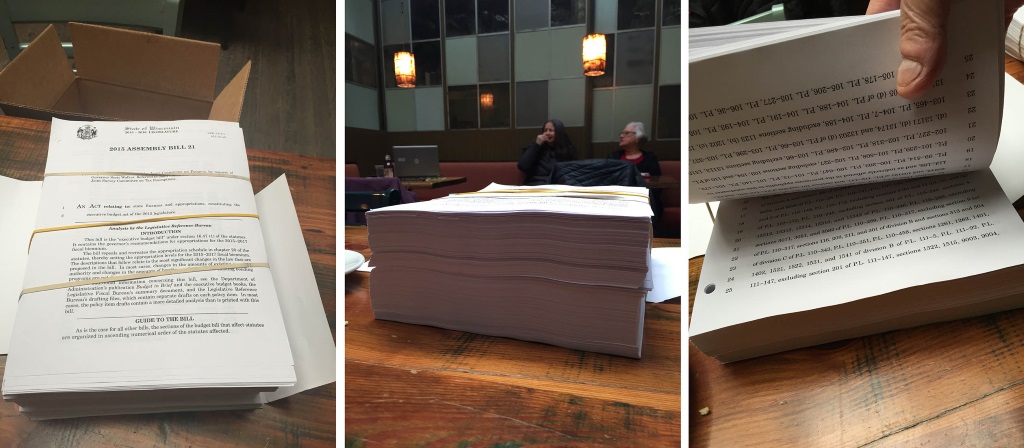Wisconsin’s Deficit Is Growing
Walker cut deficit in half, but has since grown it, could hit $2.1 billion.
Two recent state reports provide contrasting pictures of Wisconsin’s financial condition. In one, the state ended 2016 in the red with a $1.7 billion deficit. The other shows the state in the black with a $331 million surplus.
Which is correct? Confusingly, both are because they look at state finances differently.
The first, the Comprehensive Annual Financial Report (CAFR), is prepared by the state controller’s office using generally accepted accounting principles (GAAP). These official financial statements are prepared the same way businesses prepare annual shareholder reports. It shows Wisconsin with the $1.7 billion deficit.
The other document, the state budget, does not follow GAAP as a CPA would but relies on cash accounting. It shows Wisconsin with a $331 million surplus. GAAP and state budget accounting also differ in how they define general fund spending, the largest share of the state budget.
How does this apply to state finances? One example is illustrative. The state provides credits on property tax bills each December. However, it delays payment of most of those credits until the following fiscal year, which begins in July. Under cash accounting, there is no spending in the actual year the credits are provided. Under GAAP, the state has spent more than $700 million.
As the example demonstrates, GAAP takes a more complete approach to revenues and expenditures, while the state budget focuses only on items that fall within the two-year spending cycle. State officials sometimes have exploited this difference, using accounting “tricks” to shift spending from one year to the next.
The state’s financial statements reflect the cumulative growth of GAAP deficits over time. In 2000, they reported an $830 million deficit that grew to nearly $3 billion by 2011. Wisconsin reversed course in 2012, reducing its GAAP deficit by more than half by 2013, to $1.4 billion. Since then, the CAFR shortfalls have grown again to more than $1.7 billion.
Gov. Scott Walker’s (R) proposed 2017-19 budget, would eventually increase the GAAP deficit to $2.1 billion by 2019. One reason for both the shrinking and expanding general fund deficits reported in the CAFR is the growth of state budget surpluses after 2011 and the spending-down of those balances after 2014. The proposed 2017-19 state budget would reduce cash balances from about $450 million this year to $81 million by 2019.
Although states use a variety of budgetary methods, they all prepare their financial statements in their CAFRs in the same way, using GAAP. Thus, Wisconsin’s financial condition can be compared to other states by comparing their CAFRs.
As of 2015, the most recent year available for comparisons, Wisconsin’s GAAP deficit was almost $1.8 billion, slightly worse than its current level. In total dollars, Wisconsin trailed only Illinois (-$6.9 billion) and California (-$2.2 billion).
However, the GAAP deficits per person tell another story: Illinois still ranks first, at -$533 per capita, followed by Wisconsin (-$309), West Virginia (-$123), and Kansas (-$96). Among Wisconsin’s other neighbors, Iowa, Michigan, and Minnesota all had GAAP surpluses in 2015, as did 40 other states. (The full rankings are available online at www.wistax.org.)
Wisconsin state law requires the state budget to balance on a two-year cash basis, and it does. That’s why it shows a surplus. But financial statements in the CAFR show Wisconsin remains in the red, even as public officials declare the budget to be in the black.
Todd A. Berry, president of the Wisconsin Taxpayers Alliance.
WisTax
-
22 Counties Trail State in Job Growth
![Marinette County Courthouse. Photo by Bobak Ha'Eri (Own work) [CC BY 3.0 (http://creativecommons.org/licenses/by/3.0)], via Wikimedia Commons](https://urbanmilwaukee.com/wp-content/uploads/2017/10/1024px-2009-0619-Marinette-Court-185x122.jpg) Oct 11th, 2017 by Wisconsin Taxpayers Alliance
Oct 11th, 2017 by Wisconsin Taxpayers Alliance
-
Local Government Finances Are Stable
 Sep 17th, 2017 by Wisconsin Taxpayers Alliance
Sep 17th, 2017 by Wisconsin Taxpayers Alliance
-
School Spending Falls Below National Average
 Aug 29th, 2017 by Todd A. Berry
Aug 29th, 2017 by Todd A. Berry





















It would be in the best interest of taxpayers to rescind all the corporate welfare provided since 2011. The coordinated propaganda by the Bradley Foundation and it’s gasbag network of paid grifters has left this State divided and broke. And no my taxes haven’t gone down. They’ve been privatized.
Thanks again Todd Berry.
-Wasn’t the ” GAAP principles ” a Walker campaign issue at one time ?
-Another promise / pledge unfulfilled by S.K.W.
-Again : Who is the Real Adult in the room ?
@ Eric – GAAP used to be a Republican principle. That principle was thrown away because per former Assembly Majority Leader Bill Kramer, using GAAP would require them to raise taxes. Proving the Republicans would rather continue to kick the proverbial can down the road, and let the liabilities keep adding up.
For another example, look at Trump’s tax ‘reform’ plan. Huge revenue cuts funded by deficit increases, and now that a Republican is in the WH there’s no mention of our national debt.